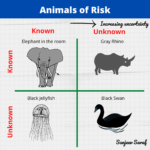Inherently safer philosophy represents a slightly different approach to risk mitigation. Instead of focusing on mitigating risks, an inherently safer alternative focuses on eliminating the hazards.Let us look at couple of inherently safer examples.
HF Alkylation
There are four alternatives available to perform alkylation:
- Pure HF: Potential high risks to community from release of toxic HF
- Modified HF: Reduced impact of HF due to reduced footprint
- H2SO4: Lower risk than pure HF but probably comparable to modified HF
- Solid Acid Catalyst: No intrinsic toxic hazard
If HF is inadvertently released to atmosphere, it poses significant risks to population in the vicinity of facility. Therefore we need to minimize the likelihood of a release and this is achieved by adding an additive to HF to reduce footprint (Alternative 2) or replacing HF by H2SO4 (Alternative 3). H2SO4 introduces risks within the plant but risks to surrounding population are lowered. Alternative 4 eliminates toxic risk by use of a solid acid catalyst.However, solid acid catalyst technology is still not regarded as “commercially proven”. More importantly, whereas Alternative 2 and 3 focus on reducing the risks, Alternative 4 is inherently safer by eliminating the hazard.
Water Treatment Using Chlorine
Chlorine is often used in water treatment to kill the pathogens. Similar to HF, a release of chlorine poses significant risks to surrounding population. An alternate to chlorine is sodium hypochlorite – chlorine salt which is solid at room temperature. By introducing sodium chlorite we have eliminated the toxic hazards from accidental release.
Formally Using Inherent Safety For Risk Mitigation
Clearly an inherently safer approach to risk management provides options which can help reduce risks. This may not always be possible; however, it is intuitive that systematic application of inherent safety principles will lead to less riskier option.It may therefore be worthwhile to integrate inherent safety analysis as a part of your risk analysis.Inherent safety reviews can focus on mitigating various risks:
- Reducing inventory to minimize consequences from terror threats
- Reduce inventory of toxic intermediates
- Alternate technologies to reduce on-site and off-site risks
- Change process conditions to minimize risk of runway reaction
- Reduce size of equipment processing hazardous chemicals
- Selection of route to minimize risks to public
More than likely an evaluation of existing processes in the light of inherently safer options will help you think-through the hazards and determine approaches to minimize the inherent hazards.So, should industry be mandated to perform inherent safety reviews? Or is the intent of inherently safer options being achieved during HAZOPs?






3 Responses
Albemarle offers an HF free alternative, alkyclean, which I rank higher when it comes to Inherent Safer Design
The biggest problem with IST is defining “safer”. How many times in the past has a “safer” chemical been substituted only to find that it presented a new set of hazards? Secondly, IST encourages even more business to be shipped overseas where IST is not mandated and/or allows these same foreign companies a competitive advantage if the mandated IST does not perform as well as the original COC. Finally, I think you would be hard pressed to find among even the staunchest supporters of IST a single person who believes that an enforcement agency like EPA or DHS is qualified to define IST for a particular product. Having worked with both agencies, I know they are not.
@DGolden
Thanks for the comments. There is no denying the uncertainty around IST definition and implementation. As a matter of practicality I suggest viewing inherent safety options as those that lower risks.
Please refer to the following posts for further details:
http://risk-safety.com/risksafetynewsite/how-risk-perception-affects-regulations/
http://risk-safety.com/risksafetynewsite/why-inherent-safety-should-be-a-part-of-security-regulation/